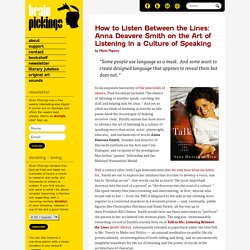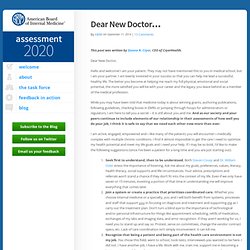

SKIP JAMES ~ Sickbed Blues. I Have A Dream Speech.
15433.jpg (JPEG Image, 336 × 224 pixels) Mediheroes-we-help-explain-illness-from-web.jpg (JPEG Image, 444 × 312 pixels) Body Types (Frank) How to Listen Between the Lines: Anna Deavere Smith on the Art of Listening in a Culture of Speaking. By Maria Popova “Some people use language as a mask.

And some want to create designed language that appears to reveal them but does not.” In his exquisite taxonomy of the nine kinds of silence, Paul Goodman included “the silence of listening to another speak, catching the drift and helping him be clear.” And yet so often we think of listening as merely an idle pause amid the monologue of making ourselves clear. Hardly anyone has done more to advance the art of listening in a culture of speaking more than artist, actor, playwright, educator, and enchantress of words Anna Deavere Smith, founder and director of Harvard’s Institute on the Arts and Civic Dialogue, and recipient of the prestigious MacArthur “genius” fellowship and the National Humanities Medal.
Smith writes: The creation of language is the creation of a fiction. Our ability to create reality, by creating fictions with language, should not be abused. We can learn a lot about a person in the very moment that language fails them. Funny-Doctor-Quotes.jpg (JPEG Image, 600 × 439 pixels) My Lovely Wife in the Psych Ward. The first time I saw my wife walking around the Georgetown campus I shouted out “Buongiorno Principessa!”

Like a buffoon. She was Italian, radiant, way out of my league, but I was fearless and almost immediately in love. We lived in the same freshman dorm. She had a smile bello come il sole—I learned some Italian immediately to impress her—and within a month we were a couple. Twelve tips for teaching social determinants of health in medicine. Medical education and the healthcare system – why does the curriculum need to be reformed?
Dear New Doctor... - Assessment 2020 : Assessment 2020. This post was written by Donna R.

Cryer, CEO of CryerHealth. Dear New Doctor, Hello and welcome! I am your patient. They may not have mentioned this to you in medical school, but I am your partner. While you may have been told that medicine today is about winning grants, authoring publications, following guidelines, checking boxes in EMRs or jumping through hoops for administrators or regulators, I am here to tell you a secret – it is still about you and me.
I am active, engaged, empowered and—like many of the patients you will encounter—medically complex with multiple chronic conditions. Seek first to understand, then to be understood.
Adverse Childhood Experiences (ACE) Study. Skip directly to search Skip directly to A to Z list Skip directly to navigation Skip directly to page options Skip directly to site content Get Email Updates To receive email updates about this page, enter your email address: CDCViolence PreventionChild MaltreatmentACE Study Adverse Childhood Experiences (ACEs) Recommend on Facebook Tweet Childhood experiences, both positive and negative, have a tremendous impact on future violence victimization and perpetration, and lifelong health and opportunity.

To prevent childhood trauma, pediatricians screen children and their parents…and sometimes, just parents…for childhood trauma « ACEs Too High. Tabitha Lawson and her two happy children When parents bring their four-month-olds to a well-baby checkup at the Children’s Clinic in Portland, OR, Drs.

Teri Petersen, R.J. Gillespie and their 15 other partners ask the parents about their adverse childhood experiences (ACEs). When parents bring a child who’s bouncing off the walls and having nightmares to the Bayview Child Health Center in San Francisco, Dr. Nadine Burke Harris doesn’t ask: “What’s wrong with this child?”
In rural northern Michigan, a teacher tells a parent that her “problem” child has ADHD and needs drugs. Watch The Program. Take the Privilege Walk. Many of us have done a "Privilege Walk" at some point in our lives.

The purpose of the walk is to expose the lifelong impact of privileges and ‘normality’ that we were either born into or born without. The exercise can very powerfully help identify all of the factors that were in place before we began making our own choices in life, factors that reinforce and widen gaps in resources and access to opportunities. The rules are simple. Everyone gathers behind a long horizontal line. When the facilitator reads a statement that applies to you, such as, “If your family owned the house where you grew up, or land of any description,” you step forward; if it doesn’t, you step back. The traditional "Privilege Walk" exercise helps unveil the distance between those who have privilege and those who don’t. The exercise: Participants form a wide circle facing the center of a room (or any open space). Childhood Community: If you had to rely primarily on public transportation, take one step forward.